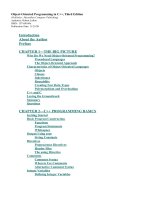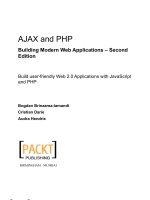Programming C#, 2nd Edition doc
Bạn đang xem bản rút gọn của tài liệu. Xem và tải ngay bản đầy đủ của tài liệu tại đây (917.23 KB, 55 trang )
Programming C#, 2nd Edition
526
if (bytesRead > 0)
{
// write it out to the client
networkStream.BeginWrite(
buffer, 0, bytesRead, callbackWrite, null);
}
If OnFileCompletedRead was called and no bytes were read, this signifies that the entire file
has been sent. The server reacts by closing the NetworkStream and socket, thus letting the
client know that the transaction is complete:
networkStream.Close( );
socket.Close( );
networkStream = null;
socket = null;
When the network write completes, the OnWriteComplete( ) method is called, and this kicks
off another read from the file:
private void OnWriteComplete( IAsyncResult ar )
{
networkStream.EndWrite(ar);
Console.WriteLine( "Write complete");
inputStream.BeginRead(
buffer, // holds the results
0, // offset
buffer.Length, // (BufferSize)
myFileCallBack, // call back delegate
null); // local state object
}
The cycle begins again with another read of the file, and the cycle continues until the file has
been completely read and transmitted to the client. The client code simply writes a filename to
the network stream to kick off the file read:
string message = @"C:\test\source\AskTim.txt";
System.IO.StreamWriter writer =
new System.IO.StreamWriter(streamToServer);
writer.Write(message);
writer.Flush( );
The client then begins a loop, reading from the network stream until no bytes are sent by the
server. When the server is done, the network stream is closed. Start by initializing a Boolean
value to false and creating a buffer to hold the bytes sent by the server:
bool fQuit = false;
while (!fQuit)
{
char[] buffer = new char[BufferSize];
You are now ready to create a new StreamReader from the NetworkStream member variable
streamToServer:
System.IO.StreamReader reader =
new System.IO.StreamReader(streamToServer);
Programming C#, 2nd Edition
527
The call to Read( ) takes three parameters: the buffer, the offset at which to begin reading,
and the size of the buffer:
int bytesRead = reader.Read(buffer,0, BufferSize);
Check to see if the Read( ) returned any bytes; if not you are done and you can set the
Boolean value fQuit to true, causing the loop to terminate:
if (bytesRead == 0)
fQuit = true;
If you did receive bytes, you can write them to the console, or write them to a file, or do
whatever it is you will do with the values sent from the server:
else
{
string theString = new String(buffer);
Console.WriteLine(theString);
}
}
Once you break out of the loop, close the NetworkStream.
streamToServer.Close( );
The complete annotated source for the server is shown in Example 21-12, with the client
following in Example 21-13.
Example 21-12. Implementing an asynchronous network file server
using System;
using System.Net.Sockets;
using System.Text;
using System.IO;
// get a file name from the client
// open the file and send the
// contents from the server to the client
public class AsynchNetworkFileServer
{
class ClientHandler
{
// constructor
public ClientHandler(
Socket socketForClient )
{
// initialize member variable
socket = socketForClient;
// initialize buffer to hold
// contents of file
buffer = new byte[256];
// create the network stream
networkStream =
new NetworkStream(socketForClient);
Programming C#, 2nd Edition
528
// set the file callback for reading
// the file
myFileCallBack =
new AsyncCallback(this.OnFileCompletedRead);
// set the callback for reading from the
// network stream
callbackRead =
new AsyncCallback(this.OnReadComplete);
// set the callback for writing to the
// network stream
callbackWrite =
new AsyncCallback(this.OnWriteComplete);
}
// begin reading the string from the client
public void StartRead( )
{
// read from the network
// get a filename
networkStream.BeginRead(
buffer, 0, buffer.Length,
callbackRead, null);
}
// when called back by the read, display the string
// and echo it back to the client
private void OnReadComplete( IAsyncResult ar )
{
int bytesRead = networkStream.EndRead(ar);
// if you got a string
if( bytesRead > 0 )
{
// turn the string to a file name
string fileName =
System.Text.Encoding.ASCII.GetString(
buffer, 0, bytesRead);
// update the console
Console.Write(
"Opening file {0}", fileName);
// open the file input stream
inputStream =
File.OpenRead(fileName);
// begin reading the file
inputStream.BeginRead(
buffer, // holds the results
0, // offset
buffer.Length, // BufferSize
myFileCallBack, // call back delegate
null); // local state object
}
Programming C#, 2nd Edition
529
else
{
Console.WriteLine( "Read connection dropped");
networkStream.Close( );
socket.Close( );
networkStream = null;
socket = null;
}
}
// when you have a buffer-full of the file
void OnFileCompletedRead(IAsyncResult asyncResult)
{
int bytesRead =
inputStream.EndRead(asyncResult);
// if you read some file
if (bytesRead > 0)
{
// write it out to the client
networkStream.BeginWrite(
buffer, 0, bytesRead, callbackWrite, null);
}
else
{
Console.WriteLine("Finished.");
networkStream.Close( );
socket.Close( );
networkStream = null;
socket = null;
}
}
// after writing the string, get more of the file
private void OnWriteComplete( IAsyncResult ar )
{
networkStream.EndWrite(ar);
Console.WriteLine( "Write complete");
// begin reading more of the file
inputStream.BeginRead(
buffer, // holds the results
0, // offset
buffer.Length, // (BufferSize)
myFileCallBack, // call back delegate
null); // local state object
}
private const int BufferSize = 256;
private byte[] buffer;
private Socket socket;
private NetworkStream networkStream;
private Stream inputStream;
private AsyncCallback callbackRead;
private AsyncCallback callbackWrite;
private AsyncCallback myFileCallBack;
}
Programming C#, 2nd Edition
530
public static void Main( )
{
AsynchNetworkFileServer app =
new AsynchNetworkFileServer( );
app.Run( );
}
private void Run( )
{
// create a new TcpListener and start it up
// listening on port 65000
TcpListener tcpListener = new TcpListener(65000);
tcpListener.Start( );
// keep listening until you send the file
for (;;)
{
// if a client connects, accept the connection
// and return a new socket named socketForClient
// while tcpListener keeps listening
Socket socketForClient =
tcpListener.AcceptSocket( );
if (socketForClient.Connected)
{
Console.WriteLine("Client connected");
ClientHandler handler =
new ClientHandler(socketForClient);
handler.StartRead( );
}
}
}
}
Example 21-13. Implementing a client for an asynchronous network file server
using System;
using System.Net.Sockets;
using System.Threading;
using System.Text;
public class AsynchNetworkClient
{
static public int Main( )
{
AsynchNetworkClient client =
new AsynchNetworkClient( );
return client.Run( );
}
AsynchNetworkClient( )
{
string serverName = "localhost";
Console.WriteLine("Connecting to {0}", serverName);
TcpClient tcpSocket = new TcpClient(serverName, 65000);
streamToServer = tcpSocket.GetStream( );
}
Programming C#, 2nd Edition
531
private int Run( )
{
string message = @"C:\test\source\AskTim.txt";
Console.Write(
"Sending {0} to server.", message);
// create a streamWriter and use it to
// write a string to the server
System.IO.StreamWriter writer =
new System.IO.StreamWriter(streamToServer);
writer.Write(message);
writer.Flush( );
bool fQuit = false;
// while there is data coming
// from the server, keep reading
while (!fQuit)
{
// buffer to hold the response
char[] buffer = new char[BufferSize];
// Read response
System.IO.StreamReader reader =
new System.IO.StreamReader(streamToServer);
// see how many bytes are
// retrieved to the buffer
int bytesRead =
reader.Read(buffer,0,BufferSize);
if (bytesRead == 0) // none? quite
fQuit = true;
else // got some?
{
// display it as a string
string theString = new String(buffer);
Console.WriteLine(theString);
}
}
streamToServer.Close( ); // tidy up
return 0;
}
private const int BufferSize = 256;
private NetworkStream streamToServer;
}
By combining the asynchronous file read with the asynchronous network read, you have
created a scalable application that can handle requests from a number of clients.
21.5 Web Streams
Rather than reading from a stream provided by a custom server, you can just as easily read
from any web page on the Internet.
A WebRequest is an object that requests a Uniform Resource Identifier (URI) such as the
URL for a web page. You can use a
WebRequest object to create a WebResponse object that









